October and Nakaoki
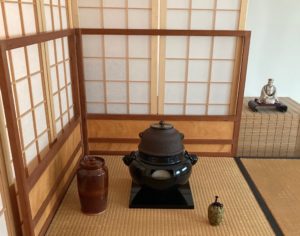
Naka-oki, 中置, middle-place, is an arrangement of utensils for a presentation in the month of October. The fu-ro, 風炉, wind-hearth, is placed in the exact center of the ten-mae, 点前, offer-fore, tatami, regardless of the size of the tatami. The shiki-ita, 敷板, spread-board, regardless of its size is placed in the center of the tatami, therefore the mizusashi is placed halfway between the left edge of the shiki-ita and the inside of the heri binding.
The mizu-sashi, 水指, water-indicate, is placed to the left of the furo. A slender and somewhat taller, hoso mizu-sashi, 細水指, narrow water-handle, is used. The center of the mizusashi aligns with the front edge of the shiki-ita, 敷板, spread-board, its shō-men, 正面, correct-face, directed toward the center of the knee line of the teishu. The cha-ki, 茶器, tea-container, is placed 7 sun kane-jaku to the right of the furo in its usual place, as though in front of the mizusashi in its original location. The center of the chaki is half the length of a cha-shaku, 茶杓, tea-scoop, away from the front edge of the shiki-ita.
The shikiita measures 9.5 sun kane-jaku square. My han-jō, 半畳, half-mat, is Kyō tatami, and measures 2.5 shaku kujira-jaku. I was astonished to learn that the distance between the edge of the shiki-ita and the edge of the tatami was 8.8 sun kujira-jaku. It is remarkable that in a standard furo tenmae, the distance between the front edge of the shiki-ita and the knee-line of the teishu is 8.8 sun kane-jaku. Hachi jū hachi, 八十八is one of the most auspicious numbers. It seems impossible to fit together both measurements of kane-jaku and kujira-jaku.
It is commonly said that the reason that the furo is placed in the center of the tenmae tatami is to bring the heat of the fires closer to the guests as the weather is getting colder in October. There is some truth to this, and it has been said so often that people believe it. It should be understood that the furo may be used throughout the year, and open the ro, 炉, hearth, in the colder seasons if one has the sunken hearth. The ro is usually opened in November, on the first day of the Wild Boar, however, if one does not have a ro, the furo is not kept in the middle of the tenmae tatami, but moved back to its original place on the left half of the tatami.
As that is the custom, there may be another reason that the furo is placed in the middle of the tatami for the month October. October, or the tenth month according to the lunar calendar, is called the Kan-na-zuki, 神無月, God-less-month, when the Shintō gods assemble in Izumo Tai-sha, 出雲大社, Out-cloud Great-shrine. What seems to have been forgotten by some people, is that the Buddhist deities stay in their altars during this period. Perhaps having the furo in the middle of the tatami is to emphasize its role as a kō-rō, 香炉, incense-hearth, censer.
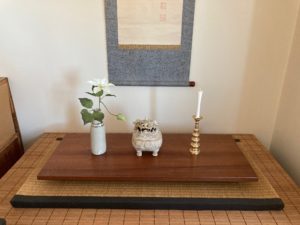
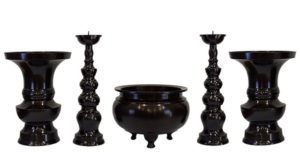
This set of utensils is placed on an altar in front of three hanging scrolls. The scroll with the image of a principal deity, such as Amida, is placed in the middle, with a scroll for each of a pair of images that often accompany the deity, such as Seishi and Kannon, who accompany Amida.
Fire and water are offered to both accompanying deities, but in opposite arrangements. Candlesticks are placed on either side of the kōro, with flower containers on the outside of the group. Accompanying deities are identified with the In, 陰, negative and Yō, 陽, positive aspects of the central deity.
In truth, it is the kōro that is specifically placed in front of the deity. The three Buddhist offerings are kō, ge, tō, 香華灯, incense, flower, light, with incense as the primary offering. Incense must be burned before guests enter the Tea room. Among the first actions of the teishu in presenting Tea, is when the futaoki/kōro is presented, and everyone bows to begin the presentation. Having the furo/kōro in the center of the tenmaeza manifests this concept of the presence of incense.
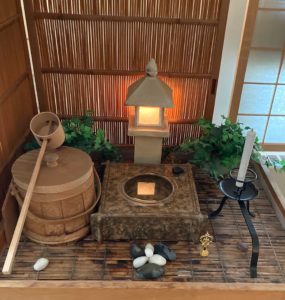
This arrangement is reflected in the arrangement of utensils in the tokonoma. The chōzu-bachi can be identified with the kōro; the water from the chōzubachi, In, 陰, negative, purifies the hands and mouth, the incense in the kōro, Yō, 陽, positive, purifies the mind and soul. The chōzubachi, central to the tsukubai, is primarily identified with the furo in the center of the tenmaeza. The water bucket is identified with the hanaire on the left side of the kōro in the tokonoma, and with the mizusashi, which is placed to the left of the furo in the Tearoom.
The candlestick is taken from the tsukubai and placed in the tokonoma on the right side.

According to the Eki-kyō, 易経, Change-sutra, the tokonoma is identified with the ha-kke, 八卦, eight-signs. The kōro is placed in the center of the ring of the hakke, and is identified with center of everything. The hanaire is placed on the trigram Kan, 坎, for Water. The rōsoku tate is placed on the trigram Ri, for Fire.
The seventh period of mourning, Jū-ichi-gatsu jū-go-nichi, 十一月十五日, Ten-one-month ten-five-day, which is presided over by A-shuku Nyo-rai, 阿閦如来, Praise-crowd Like-attain. He is one of the important Jū-san–butsu, 十三仏, Ten-three-buddhas. Ashuku is often associated with Yaku-shi Nyo-rai, 薬師如来, Medicine-master Like-attain. Yakushi resides in the Eastern Pure Land, and Ashuku is the Lord of the Eastern Land of Great Delight, which is located in the east. The color is of lapis lazuli, ru-ri, 瑠璃, which is also the color of Buddha’s begging bowl. The begging bowl of Buddha is also identified with the suspended hanaire that is hung on the hook of the tokobashira.
Ashuku holds the ya-kki, 薬器, medicine-container, which may be represented as the hanaire hanging on a hook driven into the toko-bashira. Ashuku is depicted holding a corner of his robe in his left hand, which may be identified with the teishu handling the fukusa.
This date corresponds to the location of the toko-bashira, 床柱, floor-post. This date is also associated with the Buddha’s descent from heaven.
Deity in the north
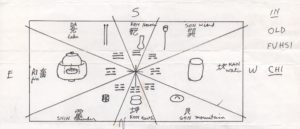
It is important to know that an ideal futaoki is the ho-ya gō-ro, 火舎香炉, fire-house incense-hearth, and that it is located in the middle of the dai-su ji-ita, 台子地板, support-of earth-board. The arrangement of the ha-kke, 八卦, eight-signs, is the old original arrangement. The upper shelf of the daisu is marked by the new arrangement of the hakke.
When the teishu sits in front of the utensils with fire on the left and water on the right, the teishu is located in the north. When water is on the left and fire in the form of a tea container is on the right, the teishu is located in the south. This is the arrangement in Nakaoki, thereby placing the teishu in the south which is subservient to the north and deity.
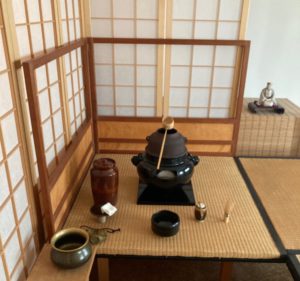
Nakaoki presentation with utensils arranged as just before placing tea into the bowl. Ki-men bu-ro, 鬼面風炉, demon-face wind-hearth, Kara-kane, 唐銅, Tang-copper, with demon mask lugs and rings; with kama, 釜, kettle, tetsu, 鉄, iron, with arare, 霰, hailstone, surface. Shin-nuri shiki-ita, 真塗敷板, true-lacquer spread-board, black-lacquered wood. Hoso mizu–sashi, 細水指, narrow water-indicate, terra cotta with amber glaze, American pottery. Cha-ire, 茶入, tea-receptacle, ‘dai–kai’, 大海, great-sea, Shiga-raki yaki, 信楽焼, Faith-pleasure-fired, with ivory lid, and silk fabric shi-fuku, 仕覆, serve-cover, [near kensui]. Cha-shaku, 茶杓, tea-scoop, bamboo, with natural split. Cha-sen, 茶筅, tea-whisk. Ken-sui, 建水, build-water, Kara–kane, bronze, e-fugo, 餌畚, feed-bag. Cha-kin, 茶巾, tea-cloth, hemp, on kettle lid, which is supported by a futa-oki, 蓋置, lid-place, aged bamboo, cylindrical fuki–nuki, 吹抜, blow-through.
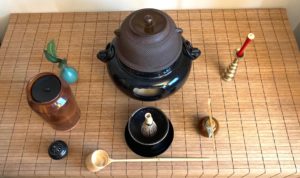
The kimen buro replaces the central Buddhist kō-ro, 香炉, incense-hearth. The amber glaze mizusashi on the left is similar to the Buddhist leaf vase. In front of the mizusashi is a hoya gōro futaoki, which is borrowed directly from a Buddhist altar. In front of the furo is a Daitenmoku chawan, with a chasen upright in the bowl. The amber glaze chaire to the right of Daitenmoku has its ivory lid inverted revealing the gold lined underside. The bamboo chashaku is placed on top of the inverted lid. It is most important to compare the hoya gōro and the chaire. At the front of the tokonoma is a bamboo hi-shaku, 柄杓, handle-ladle; L. 14 sun kane-jaku. The full width of the kimen buro is 14 sun kane-jaku, the same length as the hishaku.
Nakaoki tenmae has significance as it appears that the dōgu arrangement is similar to the arrangement of the San-gu-soku in a tokonoma. Nakaoki tenmae is presented in Kannazuki, in which the kami assemble in Izumo Tai-sha, 出雲大社, Out-cloud Grand-shrine, leaving the Buddhist hotoke, 仏,spirit, to remain in their altars. It appears that Nakaoki tenmae may be an incense burning ceremony to revere Amida Nyorai, as he is the guardian deity of the tenth lunar month.
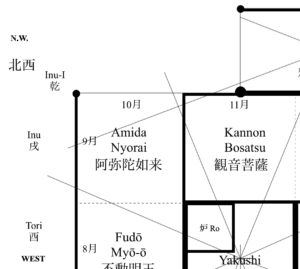
Amida is the guardian of the 9th and the 10th months. He is most revered on the 15th day of each month in accord with the man-getsu, 満月, full-moon. The influence of the full moon of both the 9th and 10th months extends inward in the yo-jō-han, 四畳半, four-mat-half, so that the influence of Amida is centered in the middle of the tatami, where the furo/kama is located.
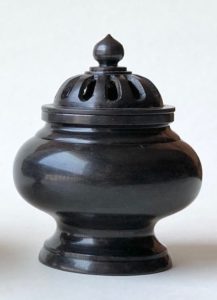
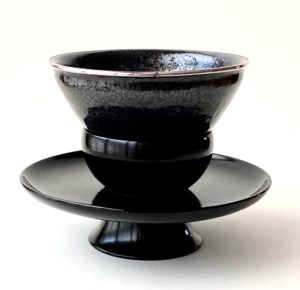
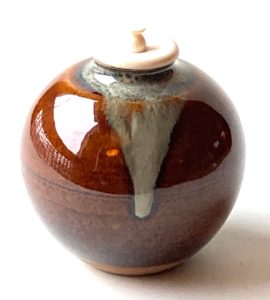
Left: ho-ya gō-ro,火舎香炉, fire-house incense-hearth, black patina Kara-kane, 唐銅, Tang-copper. Center: Dai-ten-moku cha-wan, 台天目茶碗, support-of-eye tea-bowl, black-lacquered wood three-part stand, and conical ceramic bowl. Right: cha-ire, 茶入, tea-receptacle, bun-rin, 文琳, polished-gem, ceramic jar with amber glaze.

Cha-shaku, 茶杓, tea-scoop, take, 竹, bamboo, with moto-bushi, 元節, origin-node; L. 6 sun kane-jaku.
Candle: a traditional Japanese candle is called a wa rō-soku, 和蝋燭, harmony [Japan] wax-lamp, which is made of vegetable wax. The wick, tō-shin, 灯芯, lamp-wick, is traditionally made of i-gusa, 藺草, rush-grass.
There are a wide variety of traditional candles in Japan, and many are sold by weight. A standard length for a candle for Chanoyu, which is pictured, is approximately 6 sun kane-jaku.
It is interesting to compare the similarities between the chashaku and the candle. The 6 sun lengths of the chashaku and the rōsoku, are emblematic of the number 6 which is symbolic of Infinity in Time.
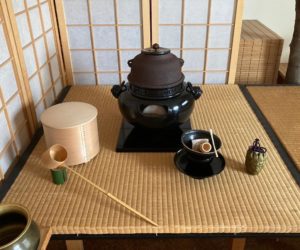
This picture is of a theoretic arrangement of utensils that is not in the standard curriculum, and is just for experimental purposes. The knot on the shifuku indicates the chaire is empty of tea. For the Nakaoki presentation, the mizu-sashi, 水指, water-indicate, is placed so that it is bisected by the line from the front edge of the shiki-ita, 敷板, spread-board. Rikyū’s mage-mono, 曲物, bent-thing, mizusashi, has a full diameter of 6 sun kane-jaku. As illustrated, there is room enough for the placement of Rikyū’s mizusashi. The futa-oki, 蓋置, lid-place, is placed directly in front of the mizusashi, and it can be seen that the handle end of the hishaku meets the center of the tatami at the knee line of the teishu. This depends also on the size of the shikiita.
When using a ō-ita, 大 板, large-board, which is 14 sun kane-jaku wide, the mizusashi must be narrower than the standard.
The placement of the shiki-ita, 敷板, spread-board, for the fu-ro, 風炉, wind-hearth, in Nakaoki presentations is exactly in the center of the dō-gu, 道具, way-tool, tatami. Shikiita vary in size. One standard is 9.5 sun kane-jaku square. Nakaoki presentation placement depends on the size of the tatami, however, the exact center is just that.
A ‘Kyō’ tatami measures 2.5 x 5 shaku kujira-jaku, or 6.25 x 31.25 sun kane-jaku. Shikiita are usually black lacquered wood, and lacquer artists use kujira-jaku for measurements. Therefore, the size of the shikiita should have kujira-jaku measurements. The standard shikiita of 9.5 sun kane-jaku is 7.6 kujira-jaku.
The distance between the edge of the 7.6 sun kujira shikiita to the outer edge of the 25-sun kujira tatami is 8.7 sun kujira. It may appear that the measurement of 8.7 might ideally be 8.8, which is a number symbolic of Infinity in Space. This may have been the intention of the ideal size of the shikiita to provide 8.8 sun kujira on each of the four sides of the shikiita. The ‘ideal’ size of the shikiita is 7.4 sun kujira-jaku, or 9.25 sun kane-jaku. The number 88 in Japanese is hachi-jū-hachi, 八十八, eight-ten-eight. The characters can be written to create the Kanji for kome, 米, rice, meaning the center of the universe.
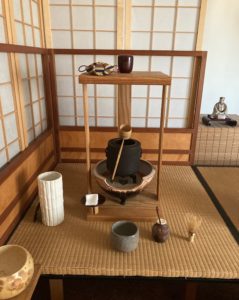
Nakaoki presentation of koi-cha, 濃茶, thick-tea. Display stand made of reassembled wooden slats of a fruit crate, modelled after Go-gyō dana, 五行棚, Transition-transition shelf, of Gen-gen-sai, 玄々斎, Mystery-mystery-abstain, XI Iemoto, Urasenke. Beni-bachi, 紅鉢, rouge-bowl, ceramic bowl with three feet by William Sōei Thrasher, Wellesley, Mass. Tsutsu-gama, 筒釜, cylinder-kettle, tetsu, 鉄, iron, with bronze lid placed on take futa-oki, 竹蓋置, bamboo lid-place. Cha-kin, 茶巾, tea-cloth, asa, 麻, hemp. White ceramic ‘bamboo’ hoso mizu–sashi, 細水指, narrow water-indicate, by Jan Palmer, West Palm Beach, Fla., with black-lacquered lid. Han-zutsu cha-wan, 半筒茶碗, half-cylinder tea-bowl, nezumi Raku, 鼠楽, rat [grey] Pleasure, by Oka Shō-ichi-ro, 岡正一郎, Hill Correct-one-son. Cha-ire, 茶入, tea-receptacle, unglazed stoneware jar by Makoto Ya-be, 誠矢部, Truth Arrow-guild, Boxford, Mass., with ivory lid, and silk bag, shi-fuku, 仕覆, serve-cover, Ao-ki kan-tō, 青木間道, Green-tree Interval-way, stripe (on shelf of display stand). Cha-shaku, 茶杓, tea-scoop, bamboo naka-bushi, 中節, middle-node, by Rev. Ulrich Haas, Kyōto. Ken-sui, 建水, build-water, dried, natural gourd.
Gen-gen-sai, 玄々斎, Mystery-mystery-abstain, XI Iemoto, created the Go-gyō dana, 五行棚, Transition-transition shelf, to display a furo / kama, as they manifest the go-gyō. The go-gyō are five physical elements: Moku Ka Do Gon Sui. Moku, 木, Wood, spring. Ka, 火, Fire, summer. Do, 土, Earth, center. Gon, 金, Metal (Gold), autumn. Sui, 水, Water, north.
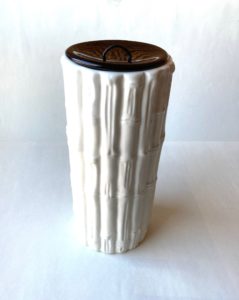

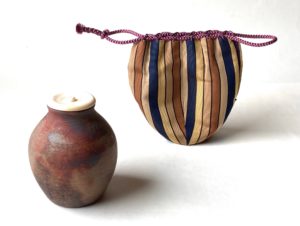
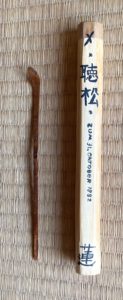
Cha-shaku, 茶杓, tea-scoop, susu-dake, 煤竹, smoke-bamboo, naka-bushi, 中節, middle-node; L. 6 sun kane–jaku, by Rev. Ulrich Haas, named ‘Toku–matsu’, 徳松, Virtue-pine, Ten-ryū-ji, 天龍寺, Heaven-dragon-temple, Kyōto.
Bamboo tomo-zutsu, 共筒, self-cylinder, with name Toku Matsu, 徳松, Virtue Pine, inscribed “zum 31. Oktober 1982” and the Kanji hasu, 蓮, lotus, that alludes to the sound of his name Haas. Haas named the chashaku for an ancient pine tree at Ten-ryū-ji, 天龍寺, Heaven-dragon-temple in Kyōto, where he had studied Buddhism, and became a monk.

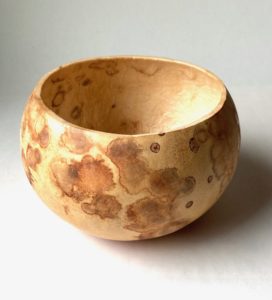
The bowl is the bottom section of a bottle gourd, hyō-tan, 瓢箪, gourd-rice basket. In Taoism, the double chamber of the bottle gourd represented a container for water and a container for rice / food, the little that one needs to live a modest life.
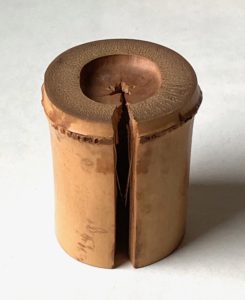
Futa-oki, 蓋置, lid-place, take, 竹, bamboo, moto-bushi, 元節, origin-node; H. 1.8 sun kane-jaku, by Nishi-kawa Bai-gen, 西川楳玄, West-river Prunus-mystery, Taka-ga-mine, 鷹ヶ峰, Hawk ’s Peak, Kyōto. The bamboo is inverted from its growth direction, with the root end up. Bamboo may split, and if a futaoki made of bamboo splits, the split becomes shō-men. The split can be likened to a toji-me, 綴じ目, seam-eye, so that the rule applies: maru-mae kaku-muko, 丸前角向, round-fore corner-opposite.
